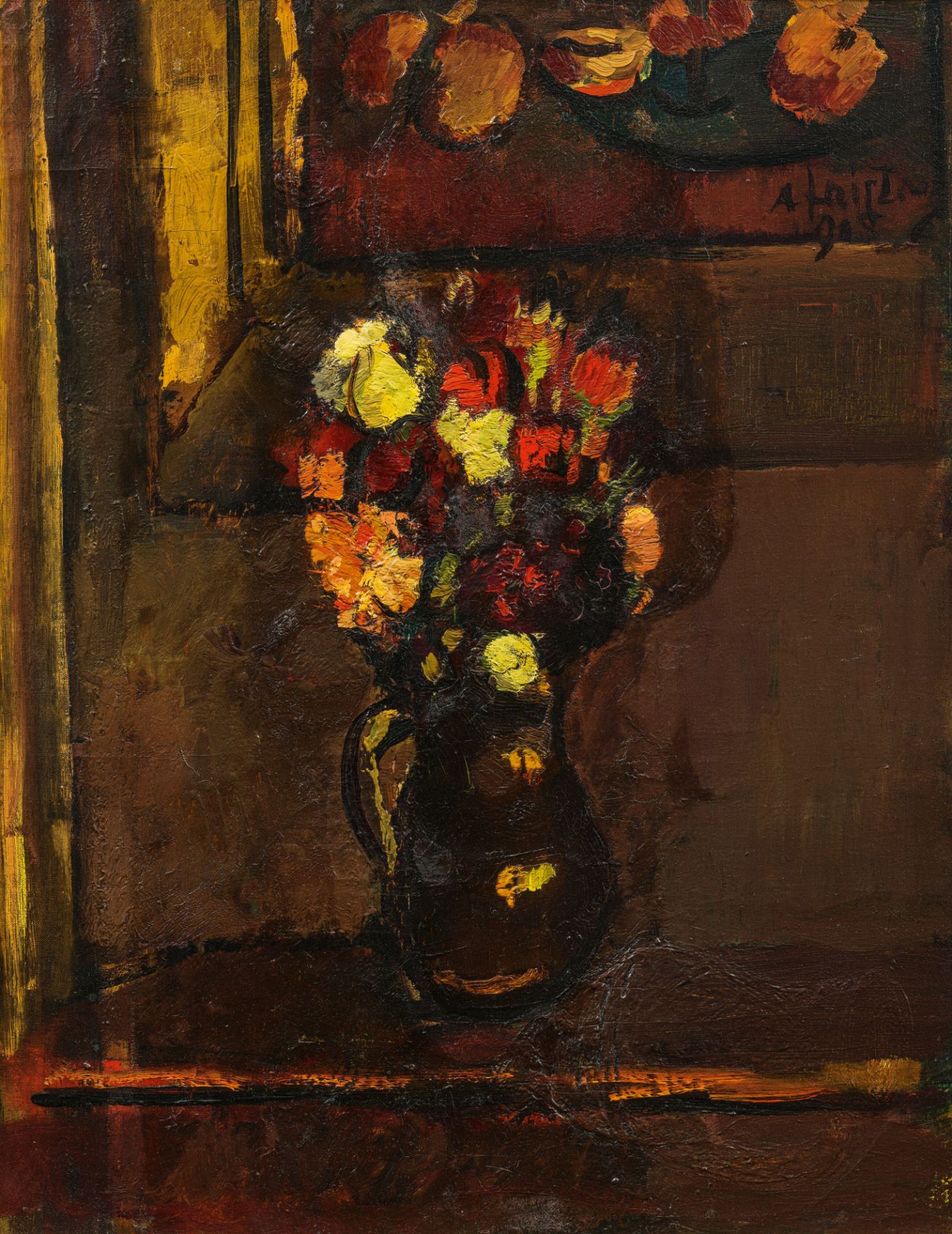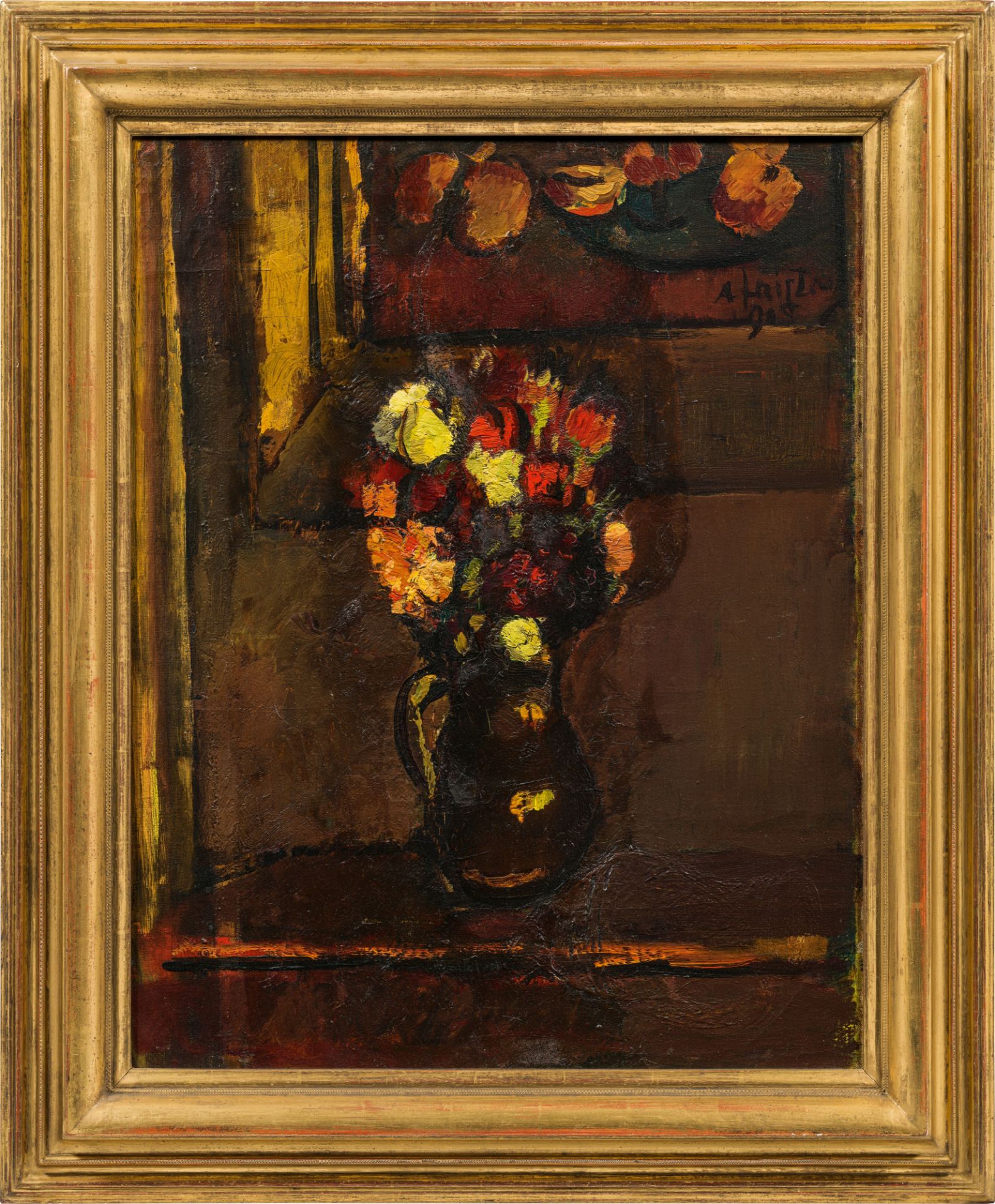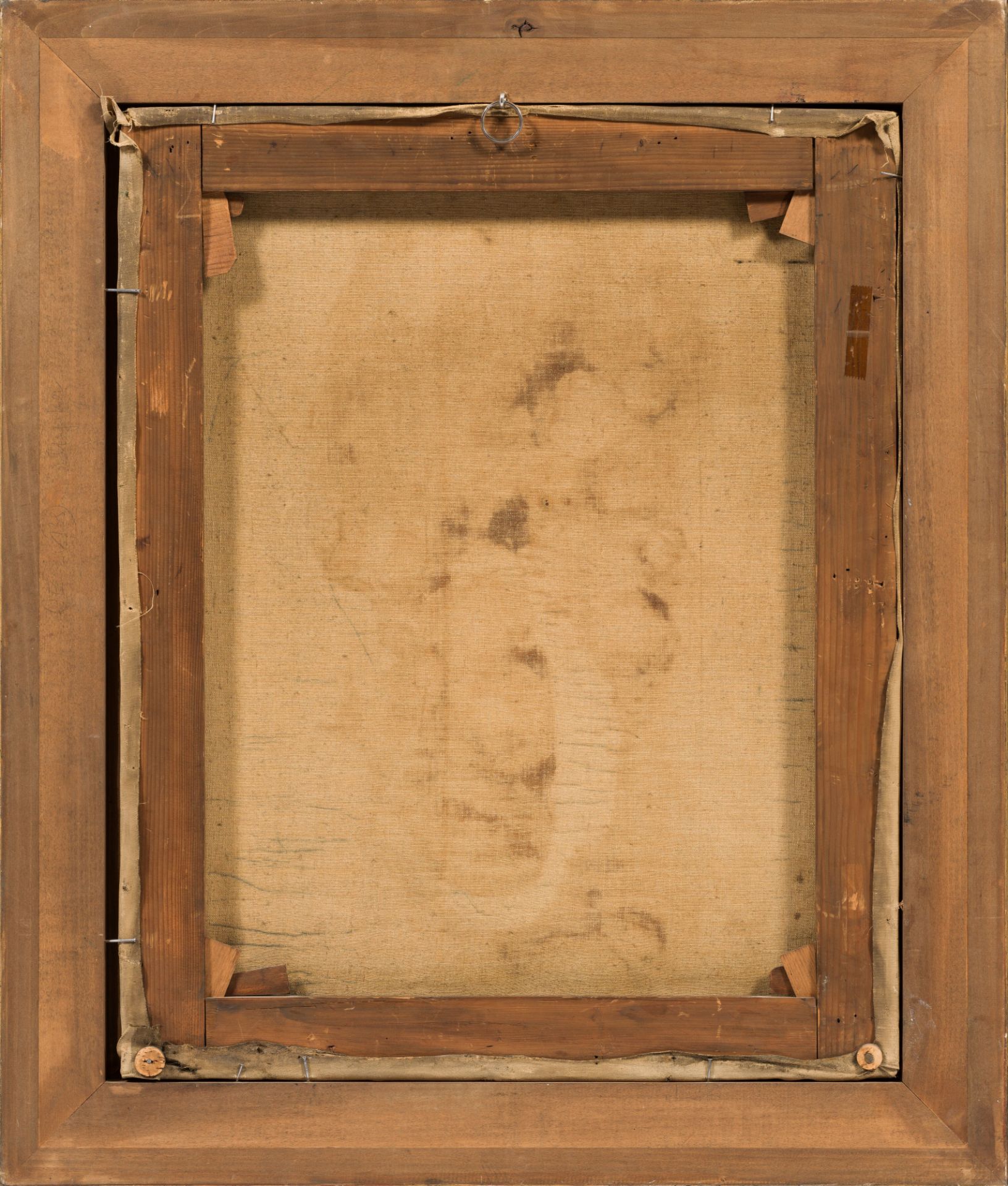17
Anton Faistauer: Blumen in Henkelkrug vor Bild
Anton Faistauer
Blumen in Henkelkrug vor Bild
1915
Öl auf Leinwand; gerahmt
67 x 53 cm
Signiert und datiert rechts oben: A. Faistauer / 1915
österreichischer Privatbesitz
Franz Fuhrmann, Anton Faistauer 1887-1930, mit einem Werkverzeichnis der Gemälde, Salzburg 1972, Nr. 29 (s/w-Abb., falsche Maße)
Anton Faistauer gehörte zu jenen Künstlern, die früh ihren künstlerischen Weg fanden. Schon vor dem Ersten Weltkrieg war er sehr erfolgreich und verfügte über ein gutes Netzwerk mit wichtigen Sammlern und Kunstfreunden. Gemeinsam mit Egon Schiele, Anton Peschka, Robin Christian Andersen, Franz Wiegele, Hans Böhler und anderen gründete er 1909 die "Neukunst-Gruppe", die aus Protest gegen den konservativen Kunstbetrieb die Akademie verließ. Im Dezember 1909 war die erste Ausstellung der von Faistauer und Schiele angeführten Gruppe der jungen Avantgarde in der Galerie Pisko am Schwarzenbergplatz zu sehen. Weitere Ausstellungen der Neukunst-Gruppe folgten 1910 in Prag und 1911 in Wien im Rahmen der für die Moderne bahnbrechenden Frühjahrsausstellung des Hagenbundes. Die österreichische Galerie kaufte 1913 erstmals ein Gemälde des bedeutenden österreichischen Expressionisten an.
Nach der Abkehr von der Flächenkunst des Jugendstils fand Faistauer in Auseinandersetzung mit Paul Cézanne, der prägenden Künstlerfigur der französischen Moderne, seine eigene künstlerische Sprache. Seine Porträts, Landschaften und Stillleben beziehen ihre Kraft aus der expressiven Farbe, einem bevorzugt dunklen, geheimnisvollen Kolorit mit unruhigen, bewegten Pinselstrichen. Unser Blumenstillleben aus 1915 zeichnet sich durch den illusionistischen Kunstgriff des Bild-im-Bild-Motivs aus. Raffiniert setzt Faistauer seine Signatur samt Entstehungsdatum rechts oben in das an der Wand hängende, vom Bildrand fragmentierte Obststilleben - ein fein kalkulierter, selbstreflexiver Verweis auf den Maler und sein Oeuvre.
(Claudia Mörth-Gasser)
Anton Faistauer
Blumen in Henkelkrug vor Bild
1915
oil on canvas; framed
67 x 53 cm
signed and dated on the upper right: A. Faistauer / 1915
private property, Austria
Franz Fuhrmann, Anton Faistauer 1887-1930, mit einem Werkverzeichnis der Gemälde, Salzburg 1972, no. 29 (b/w-ill., wrong dimensions)
Anton Faistauer was one of those artists who found their artistic path at an early age. Already before the First World War, Anton Faistauer had become very successful and had a good contact network of important collectors and art lovers. In 1909, together with Egon Schiele, Anton Peschka, Robin Christian Andersen, Franz Wiegele, Hans Böhler and others, he founded the "Neukunst-Gruppe" ("New Art Group"), who all left the Academy of Fine Arts in Vienna in protest against the conservative art establishment. In December 1909, the first exhibition of the young avant-garde group, led by Faistauer and Schiele, was held at the Pisko Gallery at Schwarzenbergplatz, Vienna. Further exhibitions of the Neukunst-Gruppe were held in Prague in 1910, and in Vienna in 1911 as part of the Hagenbund’s spring exhibition, which was a groundbreaking event for modernism. The Österreichische Galerie first purchased a painting by this important Austrian Expressionist in 1913.
After turning away from the two-dimensional style of Art Nouveau, Faistauer studied the work of Paul Cezanne, the most prominent proponent of French modernism, and thus found his own artistic language. His portraits, landscapes and still lifes draw their power from expressive colours, a preference for dark, mysterious hues with agitated, dynamic brushstrokes. Our flower still life from 1915 is characterised by the illusionist artifice of the picture-within-a-picture motif. Faistauer cleverly places his signature and the date in the upper right corner, in the still life of fruit that is hanging on the wall and partly cut off by the edge of the picture – a finely calculated, self-reflective reference to the painter and his oeuvre.
(Claudia Mörth-Gasser)
Anton Faistauer
Blumen in Henkelkrug vor Bild
1915
Öl auf Leinwand; gerahmt
67 x 53 cm
Signiert und datiert rechts oben: A. Faistauer / 1915
österreichischer Privatbesitz
Franz Fuhrmann, Anton Faistauer 1887-1930, mit einem Werkverzeichnis der Gemälde, Salzburg 1972, Nr. 29 (s/w-Abb., falsche Maße)
Anton Faistauer gehörte zu jenen Künstlern, die früh ihren künstlerischen Weg fanden. Schon vor dem Ersten Weltkrieg war er sehr erfolgreich und verfügte über ein gutes Netzwerk mit wichtigen Sammlern und Kunstfreunden. Gemeinsam mit Egon Schiele, Anton Peschka, Robin Christian Andersen, Franz Wiegele, Hans Böhler und anderen gründete er 1909 die "Neukunst-Gruppe", die aus Protest gegen den konservativen Kunstbetrieb die Akademie verließ. Im Dezember 1909 war die erste Ausstellung der von Faistauer und Schiele angeführten Gruppe der jungen Avantgarde in der Galerie Pisko am Schwarzenbergplatz zu sehen. Weitere Ausstellungen der Neukunst-Gruppe folgten 1910 in Prag und 1911 in Wien im Rahmen der für die Moderne bahnbrechenden Frühjahrsausstellung des Hagenbundes. Die österreichische Galerie kaufte 1913 erstmals ein Gemälde des bedeutenden österreichischen Expressionisten an.
Nach der Abkehr von der Flächenkunst des Jugendstils fand Faistauer in Auseinandersetzung mit Paul Cézanne, der prägenden Künstlerfigur der französischen Moderne, seine eigene künstlerische Sprache. Seine Porträts, Landschaften und Stillleben beziehen ihre Kraft aus der expressiven Farbe, einem bevorzugt dunklen, geheimnisvollen Kolorit mit unruhigen, bewegten Pinselstrichen. Unser Blumenstillleben aus 1915 zeichnet sich durch den illusionistischen Kunstgriff des Bild-im-Bild-Motivs aus. Raffiniert setzt Faistauer seine Signatur samt Entstehungsdatum rechts oben in das an der Wand hängende, vom Bildrand fragmentierte Obststilleben - ein fein kalkulierter, selbstreflexiver Verweis auf den Maler und sein Oeuvre.
(Claudia Mörth-Gasser)
Anton Faistauer
Blumen in Henkelkrug vor Bild
1915
oil on canvas; framed
67 x 53 cm
signed and dated on the upper right: A. Faistauer / 1915
private property, Austria
Franz Fuhrmann, Anton Faistauer 1887-1930, mit einem Werkverzeichnis der Gemälde, Salzburg 1972, no. 29 (b/w-ill., wrong dimensions)
Anton Faistauer was one of those artists who found their artistic path at an early age. Already before the First World War, Anton Faistauer had become very successful and had a good contact network of important collectors and art lovers. In 1909, together with Egon Schiele, Anton Peschka, Robin Christian Andersen, Franz Wiegele, Hans Böhler and others, he founded the "Neukunst-Gruppe" ("New Art Group"), who all left the Academy of Fine Arts in Vienna in protest against the conservative art establishment. In December 1909, the first exhibition of the young avant-garde group, led by Faistauer and Schiele, was held at the Pisko Gallery at Schwarzenbergplatz, Vienna. Further exhibitions of the Neukunst-Gruppe were held in Prague in 1910, and in Vienna in 1911 as part of the Hagenbund’s spring exhibition, which was a groundbreaking event for modernism. The Österreichische Galerie first purchased a painting by this important Austrian Expressionist in 1913.
After turning away from the two-dimensional style of Art Nouveau, Faistauer studied the work of Paul Cezanne, the most prominent proponent of French modernism, and thus found his own artistic language. His portraits, landscapes and still lifes draw their power from expressive colours, a preference for dark, mysterious hues with agitated, dynamic brushstrokes. Our flower still life from 1915 is characterised by the illusionist artifice of the picture-within-a-picture motif. Faistauer cleverly places his signature and the date in the upper right corner, in the still life of fruit that is hanging on the wall and partly cut off by the edge of the picture – a finely calculated, self-reflective reference to the painter and his oeuvre.
(Claudia Mörth-Gasser)
Große Jubiläumsauktion: Evening Sale
Auktionsdatum
Ort der Versteigerung
Generelle Versandinformationen vom Auktionshaus verfügbar
If you do not wish to collect your pieces from us yourself, we will arrange delivery for you. Our specialist business partners are professionals in packing, insurance and delivery and will provide these services at advantageous rates. The after-sales service usually proceeds as follows:If you would like, after the auction our logistics department will give you a quotation for transport and insurance.
If you would like to take advantage of this delivery option, contact the logistics department, after you have paid the purchase price, T +43 1 5324200-18 or r.mayr@imkinsky.com
When you place your order, your details will be sent to the appropriate shipping company. You will be contacted by our business partner to arrange a delivery date.
The price for transport and insurance is arranged directly with the shipping company.
If you don’t want to take advantage of this service, we must ask you to arrange collection yourself. We ask for your understanding that in this case we can take no responsibility for the quality of packing or transportation and can therefore take no responsibility for whether your pieces arrive intact.
Wichtige Informationen
Exhibition 17-30 November
Mon-Fri 10am-6pm
Sat & Sun 10am-5pm
AGB
Conditions of Auction
Extract from the rules of procedure
The wording of the complete rules of procedure can be viewed on our homepage www.imkinsky.com. By request we will also send the rules of procedure to you.
• Rules of Business: Auctions are conducted according to the conditions of sale as set down by Auktionshaus im Kinsky GmbH. The rules of business are available for viewing at the Auction House, and can be requested by post or email (office@imkinsky.com), they can also be called up on the internet under www.imkinsky.com.
• Estimates: In the catalogues the lower and upper estimated values are indicated and represent the approximate bid expectations of the responsible experts.
• Reserves (Limits): Sellers quite often appoint the auction house, not to sell their objects beneath certain price. These prices (= reserve/limit) usually match the lower estimate, but in special situations can also surpass them.
• Guarantee of Authenticity: The valuation, as well as technical classification and description of the art objects is carried out by the specialists of Auktionshaus im Kinsky. Auktionshaus im Kinsky guarantees the purchaser the authenticity for three years – i.e. that the authorship of the art object is as set out in the catalogue.
• Catalogue Descriptions: Catalogue information concerning techniques, signatures, materials, condition, provenance, period of origin or manufacture etc. are based on the current knowledge determined by the experts. Auktionshaus im Kinsky cannot be held responsible for the verification of these descriptions.
• Insurance: All the art objects are insured. The insurance value is the purchase price. The responsibility of the Auction House lasts until the eighth day after the auction. After that, each art object is only insured if there is an order from the purchaser to do so.
• Starting price & Hammer price: The starting price is determined by the auctioneer. The bidding rises in approximate increments of 10 % from the starting price, or from the last bid. The highest bidder acknowledged by the auctioneer will be the purchaser as long as it has reached the minimum price (reserve).
• Buyer’s Premium: For art objects which require ‘difference’ taxation the purchase price consists of the hammer price plus the sales commission of 26 %. For art objects which require ‘normal’ taxation (marked with ▲), the price consists of the hammer price plus commission of 22 %, plus VAT (13 % for paintings, 20 % for antiques). For hammer price in excess of € 300,000 we will charge a commission of 17 % (margin taxation) or 14 % (normal taxation).
• Droit de suite: Objects marked with an asterisk* in the catalogue are subject to droit de suite in addition to the purchase price. Droit de suite is calculated as a percentage of the highest bid as follows: 4 % of the first € 50,000, 3 % of the next € 150,000, 1 % of the next € 150,000, 0.5 % of the next € 150,000 and 0.25 % of the remaining amount (i.e. over € 500,000), but not exceeding a total sum of € 12,500. Droit de suite does not apply to highest bids below € 2,500.
• Absentee bids: Clients can also submit written absentee bids or bid themselves over the phone, or give an order to the broker. To do so Auktionshaus im Kinsky must have received signed order forms, (available in the catalogues), in due time.
• Telephone bids: We will do our best to establish a telephone link, but we cannot warrant for such a telephone connection.
• Online Bidding: Interested parties can participate in the auction also via the Internet. The regulations of Auktionshaus im Kinsky shall be applicable. Auktionshaus im Kinsky assumes no liability for any breakdown or loss of the Internet connection.
• Governing Law and jurisdiction: The site for the dealings between Auktionshaus im Kinsky and the purchaser is the address of Auktionshaus im Kinsky. All legal dealings or conflicts between persons involved in the auctions are governed by Austrian Law, place of jurisdiction shall be the Courts for the First District of Vienna.
Auktionsbedingungen
Auszug aus der Geschäftsordnung
Den Wortlaut der gesamten Geschäftsordnung können Sie unserer Homepage www.imkinsky.com entnehmen. Auf Wunsch senden wir Ihnen die Geschäftsordnung auch zu.
•Geschäftsordnung: Die Auktion wird nach den Bestimmungen der Geschäftsordnung der Auktionshaus im Kinsky GmbH durchgeführt. Die Geschäftsordnung liegt im Auktionshaus zur Einsicht auf, kann von jedermann per Post oder E-mail (office@imkinsky.com) angefordert werden und ist im Internet unter www.imkinsky.com abrufbar.
•Schätzpreise: Im Katalog sind untere und obere Schätzwerte angegeben. Sie stellen die Meistboterwartungen der zuständigen Experten dar.
•Mindestverkaufspreise (Limits): Oft beauftragen Verkäufer das Auktionshaus, die ihnen gehörenden Kunstwerke nicht unter bestimmten (Mindest-)Verkaufspreisen zuzuschlagen. Diese Preise (= „Limits“) entsprechen meist den in den Katalogen angegebenen unteren Schätzwerten, sie können aber fallweise auch darüber liegen.
•Echtheitsgarantie: Die Schätzung, fachliche Bestimmung und Beschreibung der Kunstobjekte erfolgt durch Experten des Auktionshauses-. Das Auktionshaus steht innerhalb von drei Jahren gegenüber dem Käufer für die Echtheit und somit dafür ein, dass ein Kunstobjekt tatsächlich von dem im Katalog genannten Künstler stammt.
•Katalogangaben: Angaben über Technik, Signatur, Material, Zustand, Provenienz, Epoche der Entstehung usw. beruhen auf aktuellen wissenschaftlichen Erkenntnissen, die die Experten ausgeforscht haben. Das Auktionshaus leistet jedoch für die Richtigkeit dieser Angaben gegenüber keine Gewähr.
•Versicherung: Die Kunstobjekte sind versichert. Versicherungswert ist der Kaufpreis. Die Haftung des Auktionshauses besteht bis zu dem auf die Auktion folgenden 8. Tag. Danach ist ein Kunstobjekt nur versichert, wenn der Käufer dies dem Auktionshaus aufgetragen hat.
•Ausrufpreis und Zuschlag: Der Ausrufpreis wird vom Auktionator festgesetzt. Gesteigert wird um ca. 10 % des Ausrufpreises bzw. vom letzten Angebot aus-gehend. Den Zuschlag erhält der Meistbietende, sofern der Mindestverkaufspreis erreicht ist. Der Käufer hat den Kaufpreis binnen 8 Tagen nach dem Zuschlag zu bezahlen.
•Kaufpreis: Bei Kunstobjekten, die der Differenzbesteuerung unterliegen, besteht der Kaufpreis aus dem Meistbot zuzüglich der Käuferprovision von 26 %. Bei Kunstobjekten, die der Normalbesteuerung (mit ▲ gekennzeichnet) unterliegen, besteht der Kaufpreis aus dem Meistbot zuzüglich der Käuferprovision von 22 % und zuzüglich der Umsatzsteuer (13 % bei Bildern, 20 % bei Antiquitäten). Bei € 300.000 übersteigenden Meistboten wird eine Käuferprovision von 17 % (Differenzbesteuerung) bzw. 14 % (Normalbesteuerung) verrechnet.
•Folgerecht: Bei Kunstobjekten, die im Katalog mit einem * gekennzeichnet sind, wird zusätzlich zum Kaufpreis die Folgerechtsabgabe verrechnet. Sie beträgt 4 % von den ersten € 50.000 des Meistbotes, 3 % von den weiteren € 150.000, 1 % von den weiteren € 150.000, 0,5 % von den weiteren € 150.000 und 0,25 % von allen weiteren, also € 500.000 übersteigenden Meistboten, jedoch insgesamt nicht mehr als € 12.500. Bei Meistboten von weniger als € 2.500 entfällt die Folgerechtsabgabe.
•Kaufaufträge: Interessenten können auch schriftliche Kaufaufträge abgeben oder telefonisch mitbieten oder den Sensal mit dem Mitbieten beauftragen. Dafür muss dem Auktionshaus zeitgerecht das unterfertigte, dem Katalog bei-liegende Kaufauftragsformular übersandt worden sein.
•Telefonische Gebote: Das Auktionshaus wird unter der ihm bekanntgegebenen Nummer eine Verbindung herzustellen trachten. Für das Zustandekommen einer Verbindung übernimmt das Auktionshaus keine Haftung.
•Online Bidding: Interessenten können an Auktionen auch über das Internet teilnehmen. Die Bestimmungen über die unmittelbare Teilnahme an Auktionsveranstaltungen gelten hierfür sinngemäß. Für das Zustandekommen einer Internetverbindung übernimmt das Auktionshaus keine Haftung.
• Gerichtsstand, Rechtswahl: Die zwischen allen an der Auktion Beteiligten bestehenden Rechtsbeziehungen unterliegen österreichischem materiellem Recht. Als Gerichtsstand wird das für den 1. Wiener Gemeindebezirk örtlich zuständige Gericht vereinbart.










